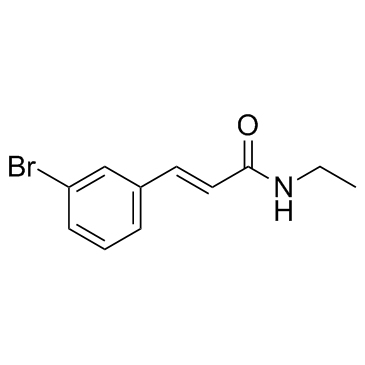Cinromide's metabolite in monkey model: gastric administration and seizure control.
J S Lockard, R H Levy, L L DuCharme, W C Congdon
Index: Epilepsia 21(2) , 177-82, (1980)
Full Text: HTML
Abstract
In a previous study (Lockard et al., 1979) Cinromide (3 bromo-N-ethylcinnamamide), an experimental anticonvulsant (Burroughs-Wellcome Pharmaceutical Co.), was given a preliminary evaluation. Since that research was concerned primarily with EEG paroxysms, the present study was conducted to address drug efficacy in terms of clinical seizures. Cinromide's major metabolite (3-bromocinnamamide, BC) was the main focus. Eight alumina-gel monkeys were given by gastric bolus every 6 hr for 10 days (Phase I) either the solvent alone (Tween 80), Cinromide (BEC), or its synthetic metabolite (SBC). Subsequently (Phase II), four animals were given BEC or SBC by chronic gastric infusion for 20 days. In both phases Cinromide's metabolite (either via BEC or especially SBC) was effective in half of the animals in reducing seizure frequency and/or duration at plasma levels above 5 mcg/m. The data suggest that the drug's efficacy is individually specific. Another species of Cinromide metabolism, 3-bromocinnamic acid, is also discussed.
Related Compounds
| Structure | Name/CAS No. | Molecular Formula | Articles |
|---|---|---|---|
 |
Cinromide
CAS:58473-74-8 |
C11H12BrNO |
|
Prediction of steady-state behavior of metabolite from dosin...
1980-05-01 [J. Pharm. Sci. 69(5) , 610-2, (1980)] |
|
Variability in the determination of fraction metabolized in ...
1984-02-01 [J. Pharm. Sci. 73(2) , 285-7, (1984)] |
|
Simultaneous determination of the anticonvulsants, cinromide...
[J. Chromatogr. A. 163(2) , 187-93, (1979)] |
|
The effect of cinromide on "kindled" seizures in the rat.
1982-03-01 [Neuropharmacology 21(3) , 273-6, (1982)] |
|
Double-blind, placebo-controlled evaluation of cinromide in ...
1989-01-01 [Epilepsia 30(4) , 422-9, (1989)] |